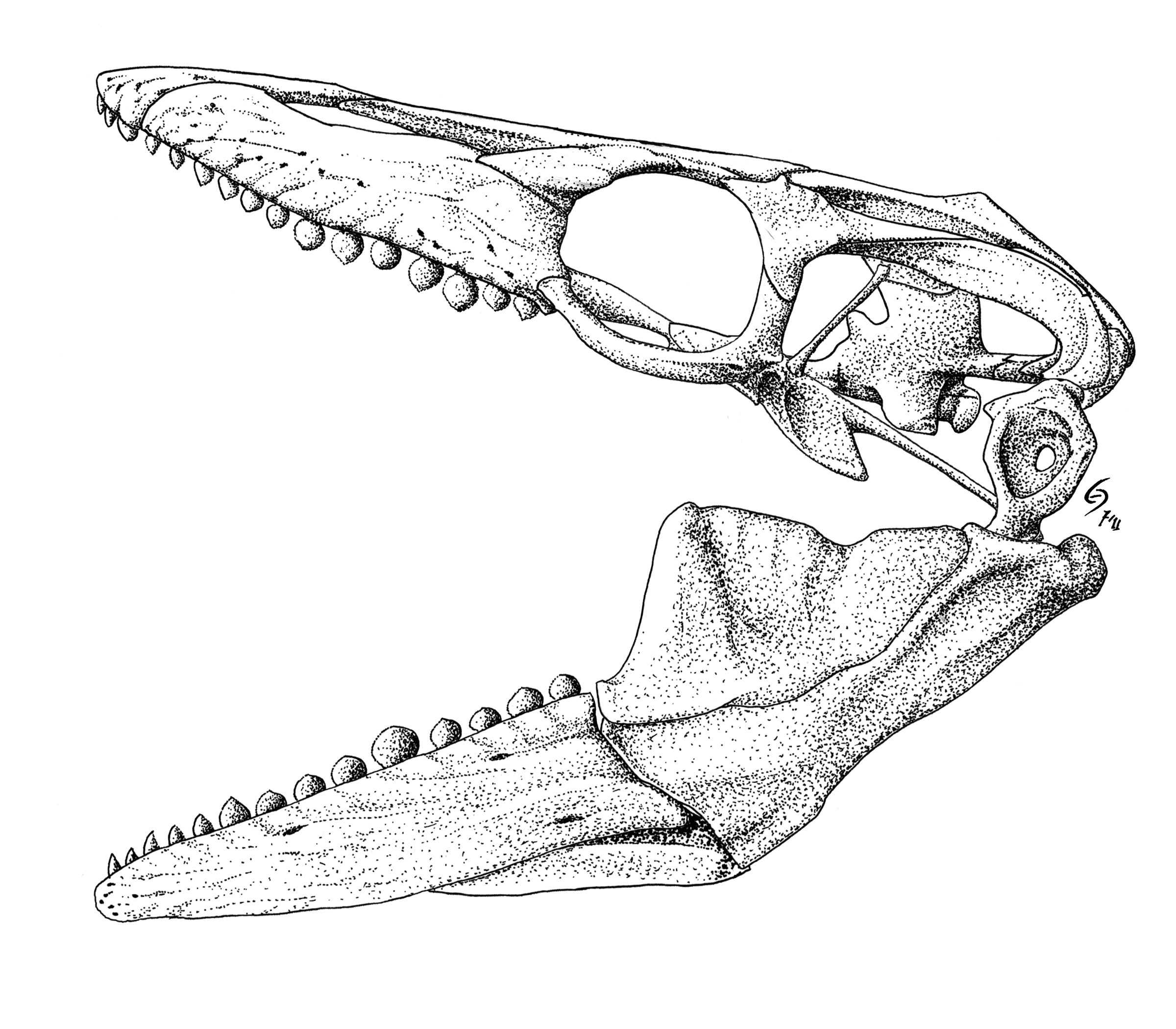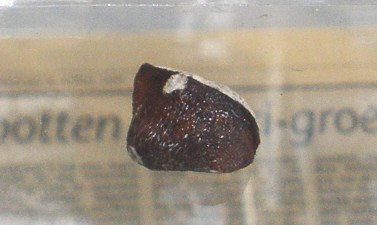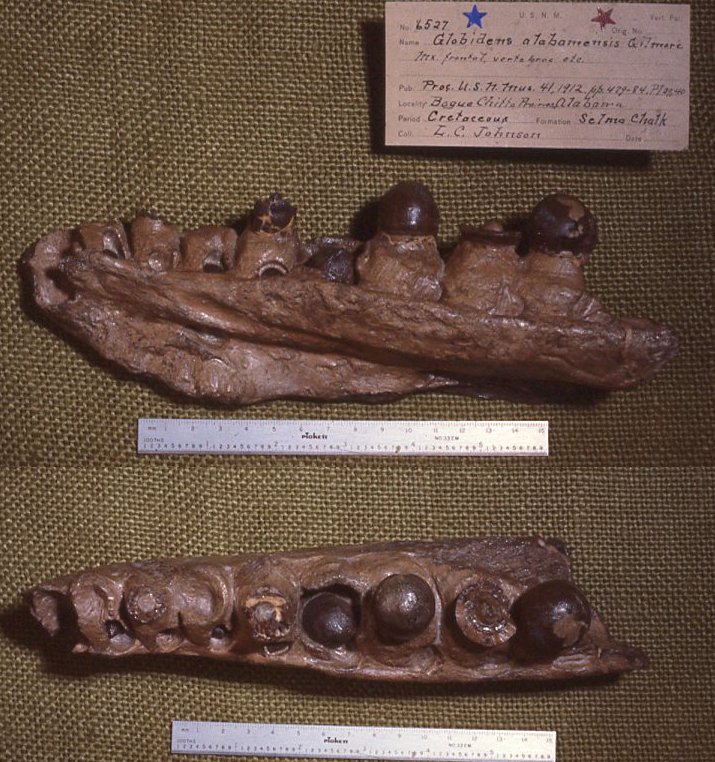|
Globidensini
The Globidensini or Globidentatini are a tribe of mosasaurine mosasaurs, a diverse group of Late Cretaceous marine squamates. Members of the tribe, known as "globidensins" or "globidensine mosasaurs", have been recovered from North America, Europe, Africa and Asia. The tribe contains the genera ''Globidens'' (the best studied genus by far), '' Carinodens'', '' Igdamanosaurus'',Schulp, Anne S., et al. "New mosasaur material from the Maastrichtian of Angola, with notes on the phylogeny, distribution and palaeoecology of the genus Prognathodon." On Maastricht Mosasaurs. Publicaties van het Natuurhistorisch Genootschap in Limburg 45.1 (2006): 57-67/ref>Lindgren, Johan. "Dental and vertebral morphology of the enigmatic mosasaur Dollosaurus (Reptilia, Mosasauridae) from the lower Campanian (Upper Cretaceous) of southern Sweden." Bulletin of the Geological Society of Denmark 52.17 (2005): e25/ref> '' Harranasaurus'' and '' Xenodens''. Features of the maxilla and digits make the placeme ... [...More Info...] [...Related Items...] OR: [Wikipedia] [Google] [Baidu] |
Carinodens
''Carinodens'' is an extinct genus of Cretaceous marine lizard belonging to the mosasaur family. "''Carinodens''" means "keel teeth" and was named in 1969 as a replacement name for ''Compressidens'', "compressed teeth", which was already in use for a gadilidan Tusk shell, scaphopod mollusk. ''Carinodens'' is widely considered a sister taxon to ''Globidens'' classified within the tribe Globidensini. Like its close relative, ''Carinodens'' also possesses distinctive round, blunt teeth for crushing primitive clams and oysters. Most of the cranial elements known from the genus have been recovered from deposits in the Netherlands, with the only known postcranial material being known from deposits of latest Maastrichtian age in Jordan.Kaddumi H. F. 2009. The first and most complete ''Carinodens'' (Squamata: Mosasauridae) skeleton yet with a description of a new species from the Harrana Fauna. In: Fossils of the Harrana Fauna and the Adjacent Areas. Publications of the Eternal River Mus ... [...More Info...] [...Related Items...] OR: [Wikipedia] [Google] [Baidu] |
Mosasaurinae
The Mosasaurinae are a subfamily of mosasaurs, a diverse group of Late Cretaceous marine squamates. Members of the subfamily are informally and collectively known as "mosasaurines" and their fossils have been recovered from every continent except for South America. The lineage first appears in the Turonian and thrived until the K-Pg mass extinction at the end of the Maastrichtian. They ranged in size from some of the smallest known mosasaurs (''Carinodens'', 3–3.5 meters), to medium-sized taxa (''Clidastes'', 6+ meters), to the largest of the mosasaurs (''Mosasaurus hoffmannii'') potentially reaching about 13 m in length. Many genera of mosasaurines were either piscivorous or generalists, preying on fish and other marine reptiles, but one lineage, the Globidensini, evolved specialized crushing teeth, adapting to a diet of ammonites and/or marine turtles. Though represented by relatively small forms throughout the Turonian and Santonian, such as ''Clidastes'', the lineage diver ... [...More Info...] [...Related Items...] OR: [Wikipedia] [Google] [Baidu] |
Igdamanosaurus
''Igdamanosaurus'', meaning "lizard from Igdaman", is an extinct genus of Cretaceous marine lizard belonging to the mosasaur family. It is classified as part of the Globidensini tribe (within the Mosasaurinae), and is like the other members of the tribe recognised by its rounded and knob-like teeth. These teeth indicate a highly specialized lifestyle, likely including a durophagous diet. The genus contains a single species, ''Igdamanosaurus aegyptiacus'', from Maastrichtian-aged marine environments of Africa. Its fragmentary fossil remains have been recovered from the Duwi Formation of Egypt, Ouled Abdoun Basin of Morocco, and the Dukamaje Formation of Niger. Description ''Igdamanosaurus'' was a small durophagous mosasaur at a size roughly similar to the closely related globidensin ''Carinodens.'' Its fossils preserve blunt, rounded teeth similar to those of the other members of the Globidensini. These teeth were better suited for crushing armored prey like molluscs and turtl ... [...More Info...] [...Related Items...] OR: [Wikipedia] [Google] [Baidu] |
Prognathodon
''Prognathodon'' is an extinct genus of marine lizard belonging to the mosasaur family. It is classified as part of the Mosasaurinae subfamily, alongside genera like ''Mosasaurus'' and ''Clidastes''. ''Prognathodon'' has been recovered from deposits ranging in age from the Campanian to the Maastrichtian in the Middle East, Europe, New Zealand, and North America. ''Prognathodon'' means "forejaw tooth", which originates from the Latin ''pro''- ("earlier" or "prior"), Greek ''gnathos'' ("jaw") and ''odṓn'' ("tooth"). Twelve nominal species of ''Prognathodon'' are recognised, from North America, northern and western Africa, the Middle East, western Europe and New Zealand. Due to the sometimes clear differences between them and the incomplete nature of many of the specimens, the systematics of the genus and which species should properly be considered ''Prognathodon'' is controversial. Some species have been assigned to other genera, such as ''Dollosaurus'' and ''Brachysaurana'', but ... [...More Info...] [...Related Items...] OR: [Wikipedia] [Google] [Baidu] |
Globidens
''Globidens'' ("Globe teeth") is an extinct genus of mosasaur lizard classified as part of the Globidensini tribe in the Mosasaurinae subfamily. ''Globidens alabamaensis'' was the first species of ''Globidens'' described, in a publication by Charles W. Gilmore (1912). It is used as the type specimen for ''Globidens''. ''Globidens'' belongs to the family Mosasauridae, which consists of several genera of predatory marine reptiles prevalent during the Late Cretaceous. Specimens of ''Globidens'' have been discovered in Syria, North America, Morocco, Angola, and Indonesia. Among mosasaurs, ''Globidens'' is probably most well known for its highly rounded, globe-like teeth. Description ''Globidens'' was a relatively medium sized mosasaur, measuring long and weighing . It was similar in appearance to other mosasaurs (streamlined body with flippers, a laterally flattened tail and powerful jaws). The teeth of ''Globidens'' differed from those of other mosasaurs in being globu ... [...More Info...] [...Related Items...] OR: [Wikipedia] [Google] [Baidu] |
Globidens Dakotensis Skull
''Globidens'' ("Globe teeth") is an extinct genus of mosasaur lizard classified as part of the Globidensini tribe in the Mosasaurinae subfamily. ''Globidens alabamaensis'' was the first species of ''Globidens'' described, in a publication by Charles W. Gilmore (1912). It is used as the type specimen for ''Globidens''. ''Globidens'' belongs to the family Mosasauridae, which consists of several genera of predatory marine reptiles prevalent during the Late Cretaceous. Specimens of ''Globidens'' have been discovered in Syria, North America, Morocco, Angola, and Indonesia. Among mosasaurs, ''Globidens'' is probably most well known for its highly rounded, globe-like teeth. Description ''Globidens'' was a relatively medium sized mosasaur, measuring long and weighing . It was similar in appearance to other mosasaurs (streamlined body with flippers, a laterally flattened tail and powerful jaws). The teeth of ''Globidens'' differed from those of other mosasaurs in being globular ... [...More Info...] [...Related Items...] OR: [Wikipedia] [Google] [Baidu] |
Globidens Dakotensis
''Globidens'' ("Globe teeth") is an extinct genus of mosasaur lizard classified as part of the Globidensini tribe in the Mosasaurinae subfamily. ''Globidens alabamaensis'' was the first species of ''Globidens'' described, in a publication by Charles W. Gilmore (1912). It is used as the type specimen for ''Globidens''. ''Globidens'' belongs to the family Mosasauridae, which consists of several genera of predatory marine reptiles prevalent during the Late Cretaceous. Specimens of ''Globidens'' have been discovered in Syria, North America, Morocco, Angola, and Indonesia. Among mosasaurs, ''Globidens'' is probably most well known for its highly rounded, globe-like teeth. Description ''Globidens'' was a relatively medium sized mosasaur, measuring long and weighing . It was similar in appearance to other mosasaurs (streamlined body with flippers, a laterally flattened tail and powerful jaws). The teeth of ''Globidens'' differed from those of other mosasaurs in being globular ... [...More Info...] [...Related Items...] OR: [Wikipedia] [Google] [Baidu] |
Mosasaur
Mosasaurs (from Latin ''Mosa'' meaning the 'Meuse', and Greek ' meaning 'lizard') comprise a group of extinct, large marine reptiles from the Late Cretaceous. Their first fossil remains were discovered in a limestone quarry at Maastricht on the Meuse in 1764. They belong to the order Squamata, which includes lizards and snakes. Mosasaurs probably evolved from an extinct group of aquatic lizards known as aigialosaurs in the Earliest Late Cretaceous with 42 described genera. During the last 20 million years of the Cretaceous period (Turonian–Maastrichtian ages), with the extinction of the ichthyosaurs and pliosaurs, mosasaurs became the dominant marine predators. They themselves became extinct as a result of the K-Pg event at the end of the Cretaceous period, about 66 million years ago. Description Mosasaurs breathed air, were powerful swimmers, and were well-adapted to living in the warm, shallow inland seas prevalent during the Late Cretaceous period. Mosasaurs were so ... [...More Info...] [...Related Items...] OR: [Wikipedia] [Google] [Baidu] |
Plesiotylosaurus
''Plesiotylosaurus'', meaning "near ''Tylosaurus''", is an extinct genus of marine lizard belonging to the mosasaur family. It is classified as part of the Mosasaurinae subfamily, alongside genera like ''Mosasaurus'' and ''Prognathodon''. The genus contains one species, ''Plesiotylosaurus crassidens'', recovered from deposits of Middle Maastrichtian age in the Moreno Formation in California. Though it is classified as a mosasaurine mosasaur, and not closely related to ''Tylosaurus'', the name is not entirely misplaced as a number of cranial features found in the relatively intact holotype skull suggest some degree of convergent evolution with tylosaurine mosasaurs. Description ''Plesiotylosaurus'' was a relatively large mosasaur. The holotype, LACM 2759, consists of a poorly preserved and partially distorted yet almost complete skull and mandibles collected from the Panoche Hills in the Moreno Formation, California. The lower jaw of the holotype skull measures in length, wh ... [...More Info...] [...Related Items...] OR: [Wikipedia] [Google] [Baidu] |
Clidastes
''Clidastes'' is an extinct genus of marine lizard belonging to the mosasaur family. It is classified as part of the Mosasaurinae subfamily, alongside genera like ''Mosasaurus'' and ''Prognathodon''. ''Clidastes'' is known from deposits ranging in age from the Coniacian to the early Campanian in the United States. ''Clidastes'' means "locked vertebrae", which originates from the Greek noun κλειδί, or kleid meaning key (akin to Latin ''claudere'' meaning to shut). This refers to how the vertebral processes allow the proximal heads of the vertebrae to interlock for stability and strength during swimming. It was one of the earliest hydropedalIn mosasaurs, the terms "hydropedal" and "plesiopedal" refers to varying limb conditions and varying degrees of adaptations for marine life. Plesiopedal mosasaurs, such as ''Dallasaurus'' or ''Tethysaurus'' were primitive and largely coastal, while later hydropedal mosasaurs were streamlined and well-adapted to marine life. mosasaurs, repr ... [...More Info...] [...Related Items...] OR: [Wikipedia] [Google] [Baidu] |
Osteology
Osteology () is the scientific study of bones, practised by osteologists. A subdiscipline of anatomy, anthropology, and paleontology, osteology is the detailed study of the structure of bones, skeletal elements, teeth, microbone morphology, function, disease, pathology, the process of ossification (from cartilaginous molds), and the resistance and hardness of bones (biophysics). Osteologists frequently work in the public and private sector as consultants for museums, scientists for research laboratories, scientists for medical investigations and/or for companies producing osteological reproductions in an academic context. Osteology and osteologists should not be confused with the pseudoscientific practice of osteopathy and its practitioners, osteopaths. Methods A typical analysis will include: * an inventory of the skeletal elements present * a dental inventory * aging data, based upon epiphyseal fusion and dental eruption (for subadults) and deterioration of the pubic symp ... [...More Info...] [...Related Items...] OR: [Wikipedia] [Google] [Baidu] |
Dale Russell
Dale Alan Russell (27 December 1937 – 21 December 2019) was an American-Canadian geologist and palaeontologist. Throughout his career Russell worked as the Curator of Fossil Vertebrates at the Canadian Museum of Nature, Research Professor at the Department of Marine Earth and Atmospheric Sciences (MEAS) at North Carolina State University, and Senior Paleontologist at the North Carolina Museum of Natural Sciences. Dinosaurs he has described include '' Daspletosaurus'' and ''Dromiceiomimus'', and he was amongst the first paleontologists to consider an extraterrestrial cause (supernova, comet, asteroid) for the Cretaceous–Paleogene extinction event. Russell also helped lead the China-Canada Dinosaur Project from 1986 to 1991. In 1982, Russell created the "dinosauroid" thought experiment, which speculated an evolutionary path for ''Troodon'' if it had not gone extinct in the Cretaceous–Paleogene extinction event The Cretaceous–Paleogene (K–Pg) extinction event (als ... [...More Info...] [...Related Items...] OR: [Wikipedia] [Google] [Baidu] |






